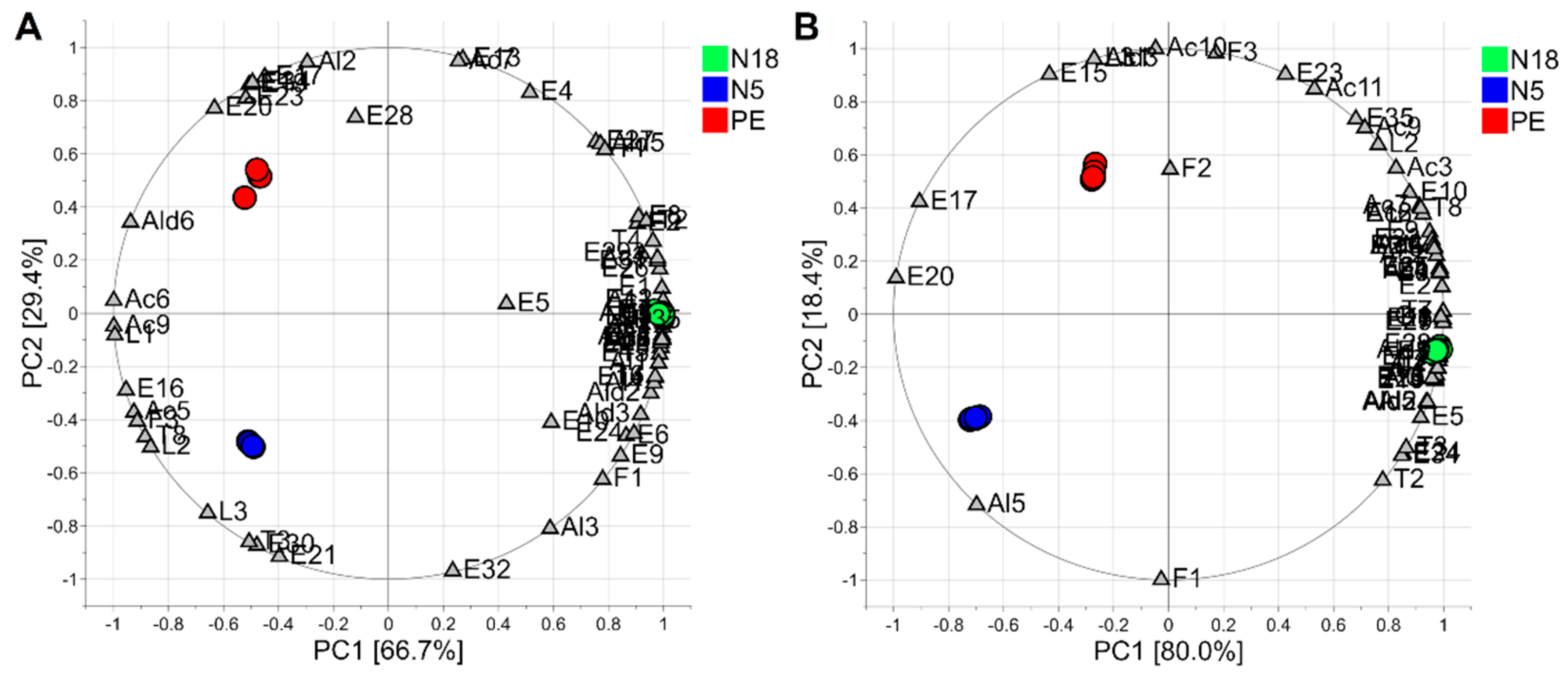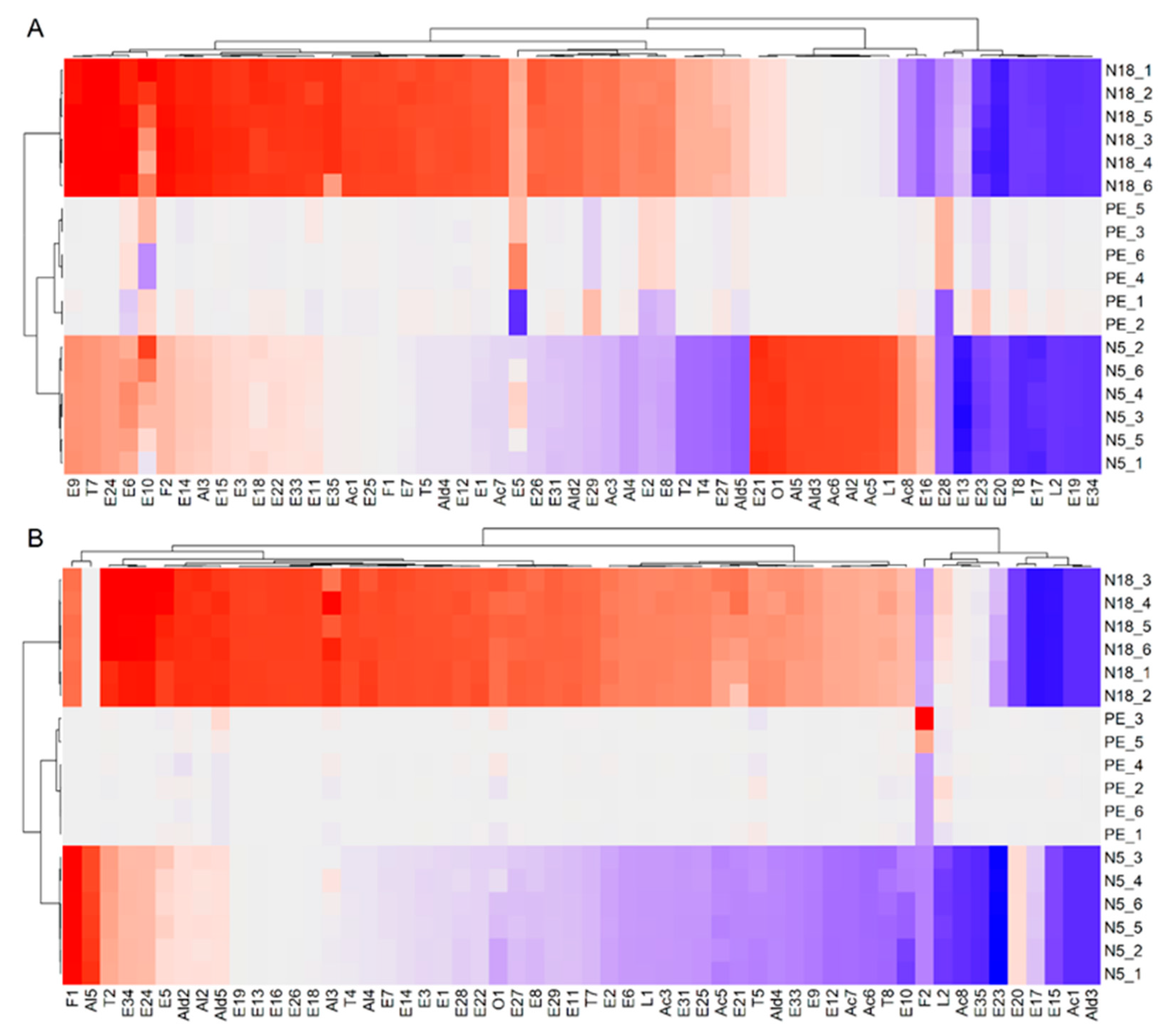New Biodegradable Mulching Films for Strawberry (Fragaria × Ananassa Duch.): Effects on the Volatile Profiles of the Fruit
Abstract
1. Introduction
2. Materials and Methods
2.1. Experimental Site and Innovative Mulch
2.2. Reagents and Chemicals
2.3. Analysis of Volatile Organic Compounds (VOCs)
2.3.1. Sample Preparation and HS-SPME Procedure
2.3.2. Gas Chromatography–Quadrupole Mass Spectrometry Analysis (GC-MS)
2.4. Statistical Data Analysis
3. Results and Discussion
3.1. Comparative Determination of VOCs Profile from “Sabrina” and “Elide” Strawberry Samples
3.2. Statistical Analysis of the VOCs Profile in the Sabrina and Elide Strawberry Samples
3.2.1. Linear Mixed-Effect Modelling (LME) on Elide Data Set
3.2.2. Linear Mixed-Effect Modelling (LME) on Sabrina Data Set
4. Conclusions
Supplementary Materials
Author Contributions
Funding
Conflicts of Interest
References
- Baltazar-Vera, J.-C.; Abraham-Juárez, M.d.R.; Torres-Arteaga, I.C.; Vargas-Ramos, N.K.; Carreño-Aguilera, G.; Ozuna-Lopez, C.; Mireles-Arriaga, A.I.; Sosa-Morales, M.E. Study of the Antioxidant and Nutraceutical Properties of Strawberry Fragaria x ananassa Organically Grown as an Option of Sustainable Agriculture. In International Business, Trade and Institutional Sustainability. World Sustainability Series; Leal Filho, W., Borges de Brito, P.R., Frankenberger, F., Eds.; Springer Publisher Nature, Switzerland AG: Cham, Switzerland, 2020; pp. 415–459. [Google Scholar]
- Cervantes, L.; Martínez-Ferri, E.; Soria, C.; Ariza, M.T. Bioavailability of phenolic compounds in strawberry, raspberry and blueberry: Insights for breeding programs. Food Biosci. 2020, 37, 100680. [Google Scholar] [CrossRef]
- Di Vittori, L.; Mazzoni, L.; Battino, M.; Mezzetti, B. Pre-harvest factors influencing the quality of berries, Sci. Hortic. 2018, 233, 310. [Google Scholar] [CrossRef]
- Rey-Serra, P.; Mnejja, M.; Monfort, A. Shape, firmness and fruit quality QTLs shared in two non-related strawberry populations. Plant Sci. 2021, 311, 111010. [Google Scholar] [CrossRef] [PubMed]
- Giordano, M.; Amoroso, C.G.; El-Nakhel, C.; Rouphael, Y.; De Pascale, S.; Cirillo, C. An Appraisal of Biodegradable Mulch Films with Respect to Strawberry Crop Performance and Fruit Quality. Horticulturae 2020, 6, 48. [Google Scholar] [CrossRef]
- Taghavi, T.; Siddiqui, R.; Rutto, L.K. The Effect of Preharvest Factors on Fruit and Nutritional Quality in Strawberry. In Strawberry-Pre- and Post-Harvest Management Techniques for Higher Fruit Quality; Asao, T., Asaduzzaman, M., Eds.; IntechOpen Publisher: London, UK, 2019; Available online: https://www.intechopen.com/chapters/65897 (accessed on 1 July 2022).
- Cozzolino, E.; Giordano, M.; Fiorentino, N.; El-Nakhel, C.; Pannico, A.; Di Mola, I.; Mori, M.; Kyriacou, M.C.; Colla, G.; Rouphael, Y. Appraisal of Biodegradable Mulching Films and Vegetal-Derived Biostimulant Application as Eco-Sustainable Practices for Enhancing Lettuce Crop Performance and Nutritive Value. Agronomy 2020, 10, 427. [Google Scholar] [CrossRef]
- Morra, L.; Bilotto, M.; Mignoli, E.; Sicignano, M.; Magri, A.; Cice, D.; Cozzolino, R.; Malorni, L.; Siano, F.; Picariello, G.; et al. New Mater-Bi, Biodegradable Mulching Film for Strawberry (Fragaria × ananassa Duch.): Effects on Film Duration, Crop Yields, Qualitative, and Nutraceutical Traits of Fruits. Plants 2022, 11, 1726. [Google Scholar] [CrossRef] [PubMed]
- Shiukhy, S.; Raeini-Sarjaz, M.; Chalavi, V. Colored plastic mulch microclimates affect strawberry fruit yield and quality. Int. J. Biometeorol. 2015, 59, 1061. [Google Scholar] [CrossRef] [PubMed]
- Fan, Z.; Hasing, T.; Johnson, T.S.; Garner, D.M.; Schwieterman, M.L.; Barbey, C.R.; Colquhoun, T.A.; Sims, C.A.; Resende, M.F.R.; Whitaker, V.M. Strawberry sweetness and consumer preference are enhanced by specific volatile compounds. Hortic. Res. 2021, 8, 66. [Google Scholar] [CrossRef]
- Cirilli, M.; Bassi, D.; Ciacciulli, A. Sugars in peach fruit: A breeding perspective. Hort. Res. 2016, 3, 1. [Google Scholar] [CrossRef] [PubMed]
- Zorrilla-Fontanesi, Y.; Rambla, J.L.; Cabeza, A.; Medina, J.J.; Sánchez-Sevilla, J.F.; Valpuesta, V.; Botella, M.A.; Granell, A.; Amaya, I. Genetic analysis of strawberry fruit aroma and identification of O-methyltransferase FaOMT as the locus control-ling natural variation in mesifurane content. Plant Physiol. 2012, 159, 851. [Google Scholar] [CrossRef]
- Jolliffe, I.T. Principal Component Analysis. In Springer Series in Statistics, 2nd ed.; Springer: New York, NY, USA, 2002. [Google Scholar]
- Parra-Palma, C.; Úbeda, C.; Gil, M.; Ramos, P.; Castro, R.I.; Morales-Quintana, L. Comparative study of the volatile organic compounds of four strawberry cultivars and it relation to alcohol acyltransferase enzymatic activity. Sci. Hortic. 2019, 251, 65. [Google Scholar] [CrossRef]
- Urün, I.; Attar, S.H.; Sönmez, D.A.; Günde¸sli, M.A.; Erci¸sli, S.; Kafkas, N.E.; Bandi´c, L.M.; Duralija, B. Comparison of Polyphenol, Sugar, Organic Acid, Volatile Compounds, and Antioxidant Capacity of Commercially Grown Strawberry Cultivars in Turkey. Plants 2021, 10, 1654. [Google Scholar] [CrossRef] [PubMed]
- Ubeda, C.; San-Juan, F.; Concejero, B.; Callejón, R.M.; Troncoso, A.M.; Morales, M.L.; Ferreira, V.; Hernández-Orte, P. Glycosidically bound aroma compounds and impact odorants of four strawberry varieties. J. Agric. Food Chem. 2012, 60, 6095. [Google Scholar] [CrossRef] [PubMed]
- Ulrich, D.; Olbricht, K. A search for the ideal flavor of strawberry-Comparison of consumer acceptance and metabolite patterns in Fragaria × ananassa Duch. J. Appl. Bot. Food Qual. 2016, 89, 223. [Google Scholar] [CrossRef]
- Fan, Z.; Plotto, A.; Bai, J.; Whitaker, V.M. Volatiles Influencing sensory attributes and bayesian modeling of the soluble solids– sweetness relationship in strawberry. Front. Plant Sci. 2021, 12, 640704. [Google Scholar] [CrossRef] [PubMed]
- Song, J.; Forney, C.F. Flavour volatile production and regulation in fruit. Can. J. Plant Sci. 2008, 88, 537550. [Google Scholar] [CrossRef]
- Ozcan, G.; Barringer, S. Effect of enzymes on strawberry volatiles during storage, at different ripeness level, in different cultivars and during eating. J. Food Sci. 2011, 71, C324. [Google Scholar] [CrossRef] [PubMed]
- Zhu, X.; Li, Q.; Li, J.; Luo, J.; Chen, W.; Li, X. Comparative study of volatile compounds in the fruit of two banana cultivars at different ripening stages. Molecules 2018, 23, 2456. [Google Scholar] [CrossRef] [PubMed]
- Zeliou, K.; Papasotiropoulos, V.; Manoussopoulos, Y.; Lamari, F.N. Physical and chemical quality characteristics and antioxidant properties of strawberry cultivars (Fragaria × ananassa Duch.) in Greece: Assessment of their sensory impact. J. Sci. Food Agric. 2018, 98, 4065. [Google Scholar] [CrossRef]
- Jetti, R.R.; Yang, E.; Kurnianta, A.; Finn, C.; Qian, M.C. Quantification of selected aroma-active compounds in strawberries by headspace solid-phase microextraction gas chromatography and correlation with sensory descriptive analysis. J. Food Sci. 2007, 72, S487. [Google Scholar] [CrossRef] [PubMed]
- Padilla-Jiménez, S.M.; Angoa-Pérez, M.V.; Mena-Violante, H.G.; Oyoque-Salcedo, G.; Renteria-Ortega, M.; Oregel-Zamudio, E. Changes in the Aroma of Organic Blackberries (Rubus fruticosus) During Ripeness. Anal. Chem. Lett. 2019, 9, 64. [Google Scholar] [CrossRef]


| Metabolite | Code | RIt/RIsp | ID | Metabolite | Code | RIt/RIsp | ID |
|---|---|---|---|---|---|---|---|
| Esters | |||||||
| Ethyl acetate | E1 | 921/921 | RI/MS/S | Ethyl 3-(methylthio)propionate | E29 | 1569/1569 | |
| Methyl propionate | E2 | 953/953 | RI/MS/S | Ethyl 2-hydroxyhexanoate | E30 | 1596/1592 | RI/MS/S |
| Methyl butyrate | E3 | 989/989 | RI/MS/S | Hexyl hexanoate | E31 | 1609/1608 | RI/MS/S |
| Methyl 2-methylbutyrate | E4 | 1016/1016 | RI/MS/S | Methyl 3-hydroxyhexanoate | E32 | 1653/1641 | RI/MS/S |
| Methyl 3-methylbutyrate | E5 | 1021/1021 | RI/MS/S | Ethyl 3-hydroxyhexanoate | E33 | 1702/1696 | RI/MS/S |
| Ethyl butyrate | E6 | 1037/1037 | RI/MS/S | Benzyl acetate | E34 | 1729/1731 | RI/MS/S |
| Ethyl 2-methylbutyrate | E7 | 1053/1053 | RI/MS/S | Ethyl cinnamate | E35 | 2145/2145 | |
| Ethyl 3-methylbutyrate | E8 | 1068/1068 | RI/MS/S | Aldehydes | |||
| Butyl acetate | E9 | 1074/1075 | RI/MS/S | Hexanal | Ald1 | 1084/1084 | RI/MS/S |
| Isoamyl acetate | E10 | 1121/1122 | RI/MS/S | 2-Hexenal | Ald2 | 1242/1242 | RI/MS/S |
| Ethyl pentanoate | E11 | 1142/1142 | RI/MS/S | Nonanal | Ald3 | 1404/1404 | RI/MS/S |
| trans-Ethyl-2-butenoate | E12 | 1179/1169 | RI/MS/S | Benzaldehyde | Ald4 | 1533/1533 | RI/MS/S |
| Pentyl acetate | E13 | 1192/1192 | RI/MS/S | Dodecanal | Ald5 | 1716/1716 | RI/MS/S |
| Methyl hexanoate | E14 | 1204/1204 | RI/MS | Tetradecanal | Ald6 | 1924/1924 | MS |
| Ethyl hexanoate | E15 | 1249/1249 | RI/MS/S | Alcohols | |||
| Isoamyl butyrate | E16 | 1277/1267 | RI/MS/S | 1-Hexanol | Al1 | 1365/1365 | RI/MS/S |
| Hexyl acetate | E17 | 1284/1285 | RI/MS/S | trans-3-Hexen-1-ol | Al2 | 1375/1376 | RI/MS/S |
| Methyl 2-hexenoate | E18 | 1288/1284 | RI/MS | cis-3-Hexen-1-ol | Al3 | 1393/1394 | RI/MS/S |
| cis-3-Hexen-1-ol acetate | E19 | 1326/1326 | RI/MS/S | trans-2-Hexen-1-ol | Al4 | 1416/1416 | RI/MS/S |
| trans-2-Hexen-1-ol acetate | E20 | 1344/1344 | RI/MS/S | 1-Octanol | Al5 | 1561/1561 | RI/MS/S |
| Ethyl 2-hexenoate | E21 | 1354/1355 | RI/MS | Acids | |||
| Methyl octanoate | E22 | 1396/1398 | RI/MS/S | Propanoic acid | Ac1 | 1545/1545 | RI/MS/S |
| Hexyl isobutyrate | E23 | 1400/1392 | RI/MS/S | Butyric acid | Ac2 | 1631/1631 | RI/MS/S |
| Hexyl butyrate | E24 | 1420/1415 | 2-Methylbutanoic acid | Ac3 | 1676/1676 | RI/MS/S | |
| Ethyl octanoate | E25 | 1439–1439 | Hexanoic acid | Ac4 | 1848/1848 | RI/MS/S | |
| trans-2-Hexenyl butyrate | E26 | 1478/1476 | RI/MS/S | Heptanoic acid | Ac5 | 1952/1952 | RI/MS/S |
| Ethyl 3-hydroxybutyrate | E27 | 1525/1525 | Octanoic acid | Ac6 | 2073/2073 | RI/MS/S | |
| Methyl 3-(methylthio)propionate | E28 | 1529/1525 | RI/MS/S | Nonanoic acid | Ac7 | 21762176 | RI/MS/S |
| Decanoic acid | Ac8 | 2278/2278 | RI/MS/S | ||||
| Terpenes | Furanones | ||||||
| β-Pinene | T1 | 1042/1042 | Mesifurane | F1 | 1592/1600 | RI/MS/S | |
| cis-Linalool oxide | T2 | 1451/1445 | Furaneol | F2 | 2042/2042 | RI/MS/S | |
| trans-Linalool oxide | T3 | 1478/1483 | trans-γ-Jasmolactone | F3 | 2188/2181 | RI/MS | |
| Linalool | T4 | 1553/1553 | RI/MS/S | Lactones | |||
| β-Farnesene | T5 | 1667/1667 | RI/MS | γ-Octalactone | L1 | 1919/1919 | RI/MS/S |
| α-Terpineol | T6 | 1702/1690 | RI/MS/S | γ-Decalactone | L2 | 2158/2158 | RI/MS/S |
| β-Damascenone | T7 | 1834/1835 | RI/MS/S | γ-Dodecalactone | L3 | 2387/2384 | RI/MS/S |
| Nerolidol | T8 | 2055/2055 | RI/MS/S | Others | |||
| Phenol | O1 | 2005/2007 | |||||
Publisher’s Note: MDPI stays neutral with regard to jurisdictional claims in published maps and institutional affiliations. |
© 2022 by the authors. Licensee MDPI, Basel, Switzerland. This article is an open access article distributed under the terms and conditions of the Creative Commons Attribution (CC BY) license (https://creativecommons.org/licenses/by/4.0/).
Share and Cite
Cozzolino, R.; Amato, G.; Siano, F.; Picariello, G.; Stocchero, M.; Morra, L.; Mignoli, E.; Sicignano, M.; Petriccione, M.; Malorni, L. New Biodegradable Mulching Films for Strawberry (Fragaria × Ananassa Duch.): Effects on the Volatile Profiles of the Fruit. Agronomy 2022, 12, 2514. https://doi.org/10.3390/agronomy12102514
Cozzolino R, Amato G, Siano F, Picariello G, Stocchero M, Morra L, Mignoli E, Sicignano M, Petriccione M, Malorni L. New Biodegradable Mulching Films for Strawberry (Fragaria × Ananassa Duch.): Effects on the Volatile Profiles of the Fruit. Agronomy. 2022; 12(10):2514. https://doi.org/10.3390/agronomy12102514
Chicago/Turabian StyleCozzolino, Rosaria, Giuseppe Amato, Francesco Siano, Gianluca Picariello, Matteo Stocchero, Luigi Morra, Emiliana Mignoli, Mariarosaria Sicignano, Milena Petriccione, and Livia Malorni. 2022. "New Biodegradable Mulching Films for Strawberry (Fragaria × Ananassa Duch.): Effects on the Volatile Profiles of the Fruit" Agronomy 12, no. 10: 2514. https://doi.org/10.3390/agronomy12102514
APA StyleCozzolino, R., Amato, G., Siano, F., Picariello, G., Stocchero, M., Morra, L., Mignoli, E., Sicignano, M., Petriccione, M., & Malorni, L. (2022). New Biodegradable Mulching Films for Strawberry (Fragaria × Ananassa Duch.): Effects on the Volatile Profiles of the Fruit. Agronomy, 12(10), 2514. https://doi.org/10.3390/agronomy12102514










